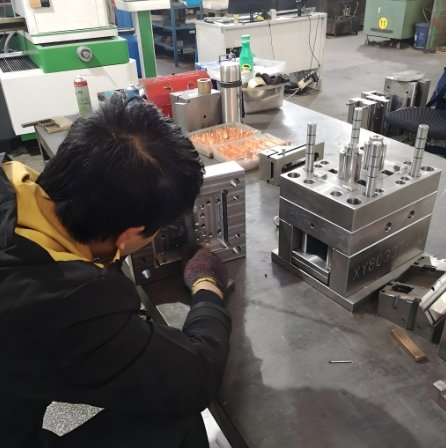
Insert molding is a key process in medical injection molding. It involves molding plastic around a metal or plastic insert. This creates strong and durable medical devices. Mold makers use this method to improve precision and efficiency.
What is Insert Molding?
1. Definition
Insert molding is a process where a pre-made insert is placed in a mold. Plastic is then injected around it.
2. How It Works
The insert is carefully positioned inside the mold. Then, molten plastic flows around it, bonding the parts together.
3. Why Insert Molding Matters
It reduces assembly steps, increases strength, and improves device reliability.
Benefits of Insert Molding in Medical Devices
1. Stronger Bonding
Plastic and inserts bond tightly. This prevents part separation.
2. Fewer Assembly Steps
No need for screws, glue, or welding. This speeds up production.
3. Improved Durability
The insert adds strength to the final part.
4. Higher Precision
Mold makers create detailed molds for accuracy.
5. Lightweight Parts
Plastic replaces heavy metal components.
6. Cost Savings
Fewer assembly steps mean lower labor costs.
Common Applications of Insert Molding in Medical Injection Molding
1. Surgical Instruments
Metal inserts improve grip and durability.
2. Implantable Devices
Insert molding secures electronic components in implants.
3. Catheters and Tubing
Plastic molds around connectors for leak-proof seals.
4. Diagnostic Equipment
Sensors and wiring are enclosed in durable plastic casings.
5. Medical Device Housings
Insert molding protects delicate electronic parts.
6. Drug Delivery Systems
Plastic components securely hold medication inserts.
Step-by-Step Insert Molding Process
1. Designing the Mold
Mold makers create precise molds for each insert.
2. Selecting the Insert
Metal, plastic, or electronic components are chosen.
3. Placing the Insert
The insert is carefully positioned inside the mold.
4. Injecting the Plastic
Molten plastic flows around the insert, bonding to it.
5. Cooling and Solidifying
The part cools and hardens inside the mold.
6. Ejecting the Finished Part
The molded part is removed and inspected.
7. Quality Control
Every part is checked for defects and strength.
Materials Used in Medical Insert Molding
1. Thermoplastics
Used for strong, lightweight medical components.
2. Liquid Silicone Rubber (LSR)
Soft and flexible, ideal for seals and tubing.
3. Polycarbonate (PC)
Impact-resistant, perfect for housings and covers.
4. Stainless Steel Inserts
Adds strength and durability to medical devices.
5. Titanium Inserts
Used in implantable medical products.
Challenges in Medical Insert Molding
1. Insert Placement Accuracy
Even slight misalignment can cause defects.
2. Material Compatibility
Plastic and inserts must bond properly.
3. Sterilization Requirements
Medical parts must withstand sterilization processes.
4. Complex Mold Design
Mold makers need advanced skills to create precise molds.
5. Cost of High-Quality Materials
Medical-grade plastics and metals can be expensive.
Role of Mold Makers in Insert Molding
1. Designing Custom Molds
They create molds for complex medical devices.
2. Ensuring Precision
Mold makers use advanced techniques for accuracy.
3. Optimizing Production
They improve cycle times and reduce waste.
4. Maintaining Mold Quality
Durable molds ensure consistent results.
Future Trends in Medical Insert Molding
1. Smart Medical Devices
Insert molding integrates sensors for real-time monitoring.
2. Miniaturization
Smaller, more precise parts for medical wearables.
3. Biocompatible Materials
Safer plastics for implantable devices.
4. AI-Driven Quality Control
Artificial intelligence improves defect detection.
Insert molding enhances medical injection molding by improving strength and precision. Mold makers ensure high-quality production. As technology advances, insert molding will continue to transform medical manufacturing.
